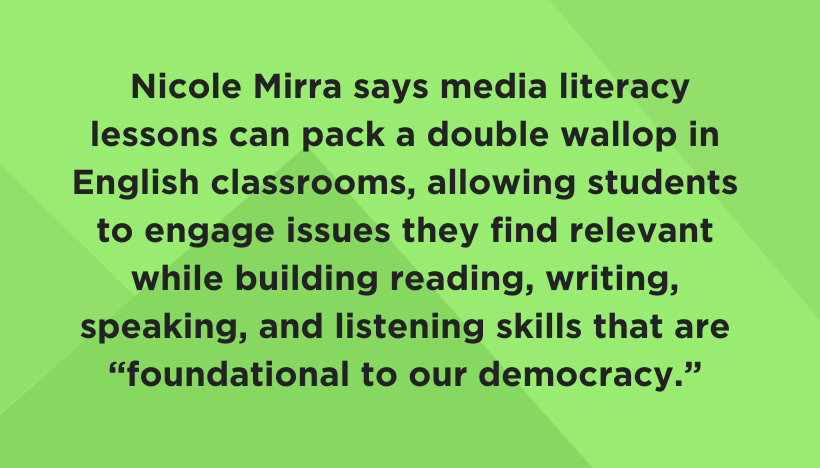This interview with NCTE member Nicole Mirra was developed by writer Trisha Collopy as a companion piece to the article “Media Literacy in the ELA Classroom: Urgent Work for Our Democracy” (The Council Chronicle, March 2021).
Imagine a classroom where students aren’t tuned out from the news of the day. Where they can have authentic conversations across the political spectrum. Where they can ask bold questions about the challenges facing their communities—and see themselves as writers and thinkers who have a voice in shaping the solutions.
That’s the environment that greeted teachers and students who participated in the yearlong Digital Democratic Dialogue (3D) Project.
The project was the brainchild of Nicole Mirra, a former high school English teacher who now works as a researcher and teacher educator at the intersection of literacy and civic engagement.
“When I became a teacher, like many, I found that the field of civic engagement was often siloed into social studies as a discipline,” she says. “My work has been around trying to dismantle that idea, because it leads to a faulty assumptions that civics is only a series of facts and figures about democracy.”
Mirra launched the 3D Project during the 2018–2019 school year with six high school English teachers from the National Writing Project network. Students in schools ranging from Anchorage, Alaska, to Philadelphia, Pennsylvania, found themselves engaged in conversations around three units:
- Who am I? How do I see myself? What are stereotypes others have about me and my community?
- What are the issues I care about? How do these issues affect me and my community? How does the news media talk about these issues? Is it helping or hurting the dialogue?
- What are your dreams about what the future of civic community could and should look like? What kind of future do you see?
By starting with questions around identity and community and then engaging with an authentic audience—each other—students were able to begin the conversation from a place of “curiosity and trust,” Mirra says.
The 3D Project model also flipped some traditional ways of teaching news literacy by first encouraging students to engage in storytelling about larger questions facing their community and then analyze the sources they trust to help them find answers and explore the whys.
“The goal isn’t just: ‘Is this objective or biased?’” Mirra says. Instead, students ask questions such as: “Why does this speak to me in my world? Why does that not speak to you? What do we have in common and where are we diverging? That’s such a different conversation from, ‘Let’s just look at the facts.’”
Mirra says media literacy lessons can pack a double wallop in English classrooms, allowing students to engage issues they find relevant while building reading, writing, speaking, and listening skills that are “foundational to our democracy.”
“We’re very lucky as English teachers because our discipline is based around skills rather than particular content,” she says.
By shaping units around skills or themes rather than texts—a race and racism unit, for example, rather than a To Kill a Mockingbird unit—teachers can open the door to a rich set of texts and more urgent conversations with their students.
“All public education has a purpose of preparing young people for the future,” Mirra says. “If we embrace that, it changes our units, changes our assignments and makes education more relevant to the world that students are navigating every day.”
 Nicole Mirra is an assistant professor of urban teacher education in the Graduate School of Education at Rutgers, the State University of New Jersey, and the author of Educating for Empathy: Literacy Learning and Civic Engagement (2018).
Nicole Mirra is an assistant professor of urban teacher education in the Graduate School of Education at Rutgers, the State University of New Jersey, and the author of Educating for Empathy: Literacy Learning and Civic Engagement (2018).
You can learn more about the 3D Project from participating teachers through this blog series.
It is the policy of NCTE in all publications, including the Literacy & NCTE blog, to provide a forum for the open discussion of ideas concerning the content and the teaching of English and the language arts. Publicity accorded to any particular point of view does not imply endorsement by the Executive Committee, the Board of Directors, the staff, or the membership at large, except in announcements of policy, where such endorsement is clearly specified.

